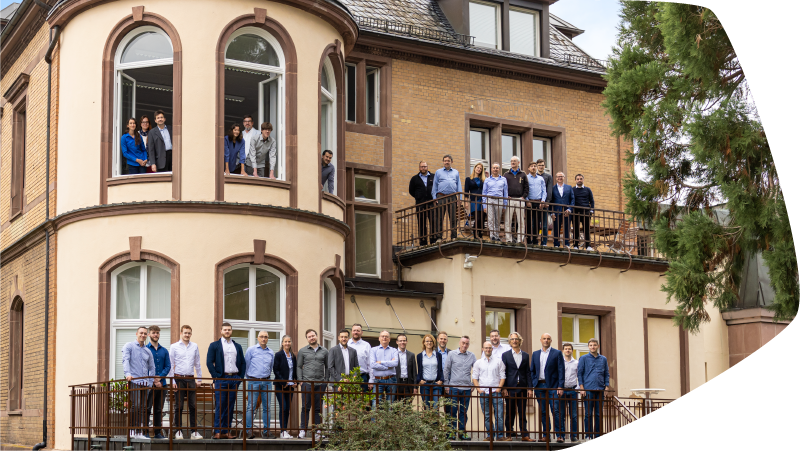
The highQ mobility platform
By combining municipal traffic data with information from/on mobility service providers in one place, mobility can be analysed, optimised and controlled. A mobility platform lays the foundation for smart, municipal mobility.

The challenge: More traffic and a partially underfunded public transport system
The urban road infrastructure is already at the limits of its capacity in many places. Further migration to urban centres and a growing need for mobility will further increase the strain.
Public transport is often underfunded, especially in rural areas, and is therefore sometimes too unattractive to be perceived as an alternative. This means that for many people, especially commuters, there is no alternative to private cars.
The consequences: Longer traffic jams, high levels of environmental pollution caused by greenhouse gases and particulate matter and therefore a lower quality of life.
The mobility platform networks existing mobility services in the best possible way
The core of a municipal mobility platform is the consolidation of data relevant to mobility.
- Mobility services: From buses and trains to car/bike sharing, e-scooters and on-demand services, the offer and status data converge in the mobility platform.
- Roadworks, traffic volume & congestion: Drivers also use the information on the platform, as we can provide the best available data on traffic volume and obstructions thanks to our connection to municipal services.
- Weather: For convenient mobility recommendations, we also include temperature and precipitation as well as severe weather warnings in our data.
- Municipal traffic strategies & danger spots: By using data on danger points, you protect cyclists, for example, and route traffic widely around schools.
- Other sensors: environmental measurement systems, parking sensors and other sensor technology reduce the amount of traffic searching for parking spaces in urban areas, among other things.
With the concentrated mobility data, you now have a wide range of options for making mobility in your region more accessible, analysing, controlling and optimising it.

A mobility platform makes mobility accessible
A journey chain with transfers is often perceived as less attractive than it actually is. The problem is that a journey with transfers usually requires several modes of transport to be linked. For example, if a passenger is not informed that they can comfortably cover the "last mile" at their destination station by e-scooter, they may decide to travel by private car after all.
A mobility platform brings together mobility services in the digital world. Via a suitable app (e.g. mytraQ) the passenger then receives a personalised, multimodal route recommendation. From bus and rail, bike and e-scooter sharing to car sharing or on-demand transport, this gives them access to the full range of attractive mobility options in your region.

Find the bottleneck at any time
The decisive bottlenecks often only become apparent when data from different sources is brought together.
In the AzweiO project, the challenge was an enormous volume of individual traffic in front of a logistics centre. This led to considerable traffic jams.
An analysis showed that public transport was not an attractive option, as there was no public transport service for the last section between the railway station and the logistics centre. The solution: a bike hire station.
The result: more than 300 employees switched to bus, train and bike hire within a few weeks.
With a mobility platform, you have the relevant data to identify the gaps and obstacles to mobility in your region.

The highQ MobilitySuite makes mobility controllable
Optimisation is possible based on the available data.
Even a small reduction in the volume of traffic can ensure that traffic jams disappear. You can use additional control mechanisms to motivate people to travel by other means of transport, at other times or on other routes.
The municipal transport infrastructure is better utilised.
highQ MobilitySuite: Basis for smart mobility services
The mobility platform can be used to develop smart transport services. Starting with the app, which makes all mobility services from buses to car sharing available in one application, to the rerouting of traffic around schools and danger zones, through to cost-efficient on-demand services for rural areas.

Smart mobility in practice: Osnabrück is multimodally networked
"Via our ... digital mobility platform, our customers receive all mobility offers ... conveniently from a single source. Thanks to the modular system structure, we can add further offers at any time ... at any time."
Maik Blome, Marketing and Sales Manager for the mobility offering of the Stadtwerke Osnabrück.
Modern data protection solutions
Smart mobility services are based on the linking of a large amount of data. Such services can be implemented in compliance with data protection regulations right from the start. Below are some of the solutions we have developed to protect personal data:
- GDPR-compliant tracking. It is rarely necessary to know the exact location of a person. We protect the privacy of your users with patented fuzzy localisation.
- Analysis of bundled data. The optimisation and management of transport services is based on the combined needs of many users. By only analysing aggregated data for analysis purposes, we respect the anonymity of the individual.
- Strict separation and deletion of data. The most personal data is usually only required for billing purposes. We therefore store such personal data separately, protect it from unauthorised access and delete it as soon as possible.
- Hosting in Germany. By hosting data only with proven providers in and from Germany, we protect it from access by unwanted parties.
At highQ, we are convinced that maximum data protection must be considered in product development right from the start. In this way, we jointly safeguard the personal rights of the individual and ensure a high level of acceptance of our mobility solutions.

Towards a better future with mobility for the common good

Our smart mobility services are part of our endeavours to achieve mobility that is in line with the common good.
Vision: Better quality of life for everyone
Städtische Straßen und Plätze werden nicht mehr vom Verkehr beherrscht, sondern gehören wieder den Menschen. Der ländliche Raum bleibt attraktiv für Jung und Alt. Dank intelligenter, multimodaler Mobilität gelangen alle sozial verantwortlich und umweltschonend an ihr Ziel.
Mission: Advancing the transport revolution
Socially responsible mobility requires a change in habits. With innovative digital solutions, we want to convince people that flexible mobility behaviour sustainably improves quality of life.

highQ: Over 25 years as a partner for fair and sustainable mobility solutions
With more than 25 years of experience, highQ is your reliable partner for future-orientated mobility solutions. Together we design the building blocks of sustainable mobility. Whether high technical requirements, new functionalities or legal regulations: Thanks to our team of experts, we will find the ideal solution for you.





Let's shape the future of mobility together.
Do you have any further questions about the highQ MobilitySuite?
Kai Horn and his team will be happy to answer your questions.






